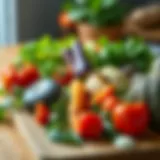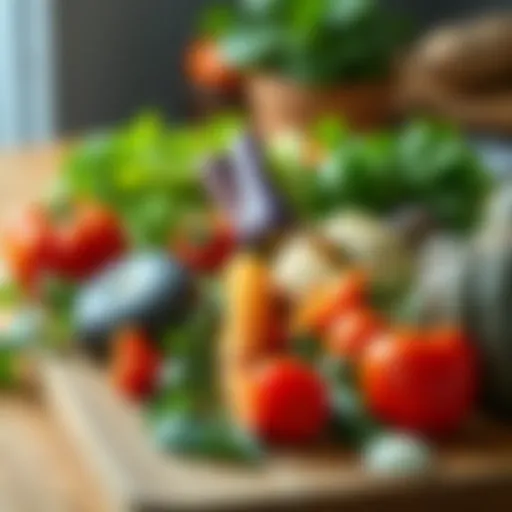Decent Chardonnay: Exploring Varietals and Terroirs
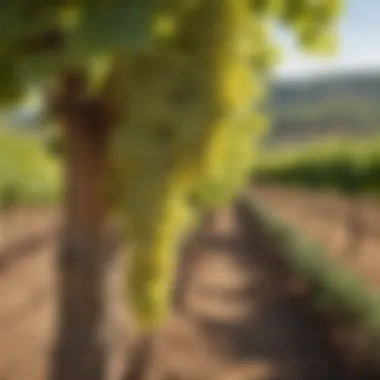

Intro
Chardonnay is a grape variety that evokes a wide range of responses and engagements from wine lovers. Known for its versatility, there is much to explore with this varietal. This journey will include details about its origins, the different expressions based on terroir, and the styles that winemakers embrace. Notably, food pairings can elevate the tasting experience, making knowledge of which dishes go well with Chardonnay quite essential.
Understanding Chardonnay encompasses an examination of specific climates and soils culminating in unique flavor profiles. This guide aims to enhance your familiarity and appreciation of this celebrated varietal.
Ingredients Breakdown
Although Chardonnay is a grape variety, the “ingredients” involved in appreciating it are more extensive. This encompasses the wine itself, elements surrounding its production, and proper pairing with food.
Primary Ingredients
- Chardonnay grapes: The base component, exhibiting characteristics much determined by terroir.
- Yeast: Vital for fermentation, affecting aroma and flavor complexity.
- Oak barrels: Used in aging, influencing flavor depth,
Optional Ingredients
- Oak chips: Sometimes used during fermentation for unique oak characters.
- Additives: Certain winemakers may use clarifying agents.
Essential Kitchen Tools
- Wine glasses: To enhance aroma collection and taste perception.
- Decanter: Useful for aerating young whiskies and softening flavors.
- Corkscrew: Essential for opening the bottle properly.
Terroir and Its Influence
Terroir refers to the environmental factors impacting grape cultivation. A vineyard's location, soil type, and climate conditions all contribute distinctively to the taste of the wine. The expressions of Chardonnay differ largely due to these factors. For instance, Chardonnay from Burgundy exhibits a different flavor profile than that from California. Flavors range from crisp green apple to rich tropical fruit.
"Understanding terroir allows wine enthusiasts to explore not just Chardonnay, but also their personal preferences."
In warm climates, flavors tend toward ripe fruits, whereas cooler regions highlight acidity and minerality. Regions such as Napa Valley are known for fuller-bodied, oaked Chardonnays, while Chablis in France lets the grape shine with clarity.
Styles of Chardonnay
The versatility of Chardonnay means one can find various styles, primarily categorized into two: oaked and unoaked. Oaked Chardonnay tends to present butter and vanilla notes, resulting from fermentation in oak barrels. In contrast, unoaked Chardonnay typically is lighter and crisper. Something like a Chablis style puts forth green apple and citrus forward with an unmistakable minerality.
Food Pairing Principles
Pairing decision for wine involves making choices not just according to sharp contrasts, but also compatible profiles. For instance:
- Oaked Chardonnay: Consider pairings like roasted chicken or creamy pasta based dishes. The buttery flavor connects symbiotically with dishes that have a fatty mouthfeel.
- Unoaked Chardonnay: This style complements seafood, salads, and dishes highlighted with citrus elements.
Understanding these guidelines enhances enjoyment and establishes thoughtful connections while savoring Chardonnay. Choosing the right pairings encourages a more profound appreciation.
Chardonnay might seem simple on the surface, but its nuances reflect something far deeper. An informed selection alongside a worthy meal enhances an overall enjoyable experience, whether from a cellar or supermarket shelf.
Understanding Chardonnay
Chardonnay holds a prominent position in the wine world, embodying uniqueness and versatility. Its significance transcends beyond merely being a grape; it represents a spectrum of flavors, aromas, and experiences. This section aims to lay the foundation for a thorough understanding of Chardonnay, discussing its origins, characteristics, and how various factors influence its cultivation and flavor.
Origins of Chardonnay
The roots of Chardonnay trace back to the Burgundy region of France, where it was first cultivated. Historical records suggest that this varietal dates back to the Roman times. Doris and Kehl κοννο πικρίνדרες ('hungry scourge') played significant roles in the grape's adaptation in the region.
Over time, Chardonnay adapted to various environments, gaining different characteristics influenced by diverse climates and soils. The grape thrives in well-drained soils, arising from limestone and clay. This helps promote healthy growth conditions and develop strong flavors in the grapes.
Claude Monet's paintings depicted beautiful vineyards that reference the essence of Burgundy, the birthplace of this celebrated grape. As a growing population of wine enthusiasts learned about the heritage of Chardonnay, its reputation spread quickly beyond borders.
Global Spread of Chardonnay
Chardonnay has become a global ambassador for the wine community. From its birthplace in Burgundy, it found footholds in regions such as California, Australia, and South Africa. Each area embraced Chardonnay, adapting it to match their environmental factors.Some may point to:
- The diverse climates ranging from the cool temperatures of Sonoma to the warmer regions of the Napa Valley.
- The unique soils, which can vary dramatically within a single growing place, contributing to a range of flavor profiles.
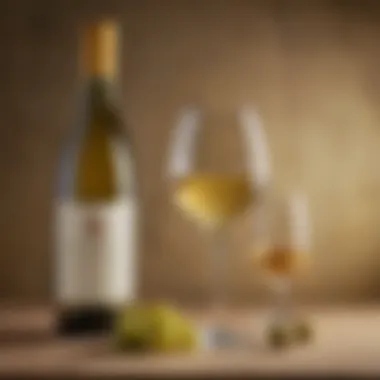

These areas have embraced the grape and found successful methods for both oaked and unoaked versions. This adaptability allows for a wide variety of styles, from crisp and mineral to rich and oaky. Regions like Chablis in France offer unoaked styles with high acidity, while the New World versions often feature oak aging to bring in lush, buttery notes.
The flexibility of Chardonnay allows winemakers to craft wines that reflect their unique environmental influences, while also catering to consumer preferences.
With its global presence, Chardonnay remains a favorite, ensuring a wide selection for wine lovers of all levels. It symbolizes connection, tradition, and ultimately, enjoyment, making it essential knowledge for anyone looking to understand wine better.
The Characteristics of Chardonnay
The characteristics of Chardonnay play a pivotal role in the appreciated complexity of this grape variety. Understanding these elements gives both novice drinkers and seasoned enthusiasts the toolkit they need to explore the nuanced atmosphere that surrounds this popular wine. The importance of the tasting notes, along with the visual appeal and aroma, cannot be overstated. These characteristics help wine lovers to identify quality and variations between different vintages and styles.
Tasting Notes
Chardonnay can exhibit a wide range of tasting notes, reflecting not just the method used in its production, but also the specific terroir from where the grapes originated. Often characterized as having flavors ranging from apple and pear to tropical fruits like pineapple and mango, Chardonnay’s complexity escalates when considering secondary characteristics.
Many Chardonnays will present creamy textures, especially those that undergo malolactic fermentation. This process softens the wine's acidity, bringing forth buttery flavors. A classic oaked Chardonnay may include hints of vanilla and toasty almond due to barrel aging. Alternatively, unoaked variants allow for brighter acidity, focusing more on fruit-forward tasting experiences, making it crucial for connoisseurs to consider when selecting a bottle.
In choosing a Chardonnay, think about the balance of fruit, acidity, and any oak influence present in the wine.
As such, understanding tasting notes involves identifying central flavors along with their intensities, which is essential for harmonizing the wine with your meal or occasion.
Color and Aroma
The visual appeal of Chardonnay, indicated by its color, often hints toward the flavor and style one can expect. Typically, younger Chardonnays exhibit a pale yellow hue. As they age, they can deepen to a golden or even amber shade, which might suggest ripe aromas and complex tastes.
Aroma is closely linked to flavor. The aromatic profile of Chardonnay ranges from floral notes to ripe fruits and honey. This aromatic journey varies greatly based on the wine's aging process. An unoaked Chardonnay often displays fresh citrus and green apple aromas, while an oaked version can present spicy notes accented by vanilla and hazelnut. Appreciation for these characteristics can guide the selection and enhance the pairing experience.
In summation, mastering the characteristics of Chardonnay equips wine enthusiasts with the knowledge to select high-quality bottles tailored to their palate. The varied tasting notes combined with distinctive color and aroma set this grape apart in any fine collection.
The Influence of Terroir
The concept of terroir is critical in understanding why Chardonnay exhibits such diverse characteristics across various regions. Terroir encompasses several factors, including soil composition, climate, and even cultural practices in winemaking. These elements together, influence not just the flavor profiles but also the overall quality of Chardonnay. The exploration of terroir allows both novice and experienced wine drinkers to appreciate how regional characteristics play a significant role in the final expression of the wine. The deeper you engage with this idea, the better you can understand what elevates a Chardonnay from decent to exceptional.
Soil Types and Their Impact
Soil types profoundly affect the growth and development of Chardonnay grapes. Different regions have unique soil compositions, which contribute distinct characteristics to the wine. For instance,
- Limestone Soil: Commonly found in Burgundy, which is revered as a benchmark for high-quality Chardonnay. The drainage capability of limestone enhances grape concentration.
- Clay Soil: This can retain moisture, making them useful in drier climates. The slight richness of wines from clay soils gives a pleasing texture, some green apple nuance can often arise.
- Sandy Soil: Known for encouraging finesse and aromatic complexity. Regions producing Chardonnay on sandy soils tend to yield wines with finesse and subtle flavors.
Stone and gravel soils also present their offerings, imparting minerals that tend to elevate the wine's crispness and acidity, balancing the richness often found in Chardonnay. An understanding of the interplay between soil types and grape qualities can guide one’s choice toward a remarkable Chardonnay experience.
Climate Considerations
While soil plays a central role, the climate where Chardonnay grapes are cultivated cannot be overlooked. Climate defines the growing season, affects sugar concentration, and influences acidity levels in the grapes. Chardonnay shines in temperate climates, which provide sufficient warmth necessary for maturity. Grapes harvested from cooler regions result in crisper, more acidic wines, while those from warmer climates express riper fruit flavors.
Factors include:
- Temperature Variability: Regions with a broad temperature range between day and night enhance the development of aromatic compounds.
- Rainfall Patterns: An optimal amount of rain during the growing season ensures healthy grape maturation without excess, which can dilute flavors.
- Sunlight Exposure: Sunlight impacts photosynthesis, subsequently affecting flavor concentration. Cooler regions typically benefit from specific orientations providing optimal sun exposure.
“The variability shaped by soil and climate is what cultivates the brand identity of Chardonnay across regions.”
By comprehending these components, wine individuals can elevate their selection processes, guided not just by specific brands or popularity but by each wine’s foundational characteristics rooted in its terros.
Exploring Different Styles of Chardonnay
Chardonnay is celebrated for its adaptability, offering a variety of styles that cater to diverse palates. Understanding these different styles of Chardonnay is critical for wine lovers. Each expression not only reflects unique terroirs but also the choices made during the vinification process. This section helps to clarify the nuances between styles, thereby enhancing the wine selection experience for enthusiasts.
Oaked vs.
Unoaked Chardonnay
The quest to unearth the fundamental expression of Chardonnay often leads to a key distinction: oaked versus unoaked varieties. Oaked Chardonnay is aged in wooden barrels, typically oak, which imbues the wine with rich flavors of vanilla, spice, and cream. The aging process allows for micro-oxygenation, enhancing its complexity and smoothness. Many aficionados appreciate this style for its luxurious mouthfeel and layered aromatics.


Conversely, unoaked Chardonnay presents a more straightforward representation of the grape. It showcases bright acidity with pure fruit flavors like green apple, pear, and citrus. This style often appeals to those who prefer a fresher, cleaner taste of wine. The choice between oaked and unoaked is ultimately a matter of personal preference and can greatly influence the wine's pairing with food.
The style of Chardonnay may enhance or drastically alter the tasting experience depending on its aging processes.
Sparkling Chardonnay
In the realm of sparkling wine, Chardonnay takes on a new identity. Often used in prestigious Champagne, this varietal is known for its ability to produce elegant and complex sparkling wines. The process involves secondary fermentation, resulting in those iconic bubbles that elevate any occasion.
Sparkling Chardonnay often exhibits flavors of citrus, brioche, and almond, accompanied by a refreshing zest. The crisp acidity achieves a perfect balance with creamy textures, making it ideal for festive gatherings. A notable distinction within this category is the use of traditional methods versus tank methods. The former often results in superior quality and character.
Late Harvest and Dessert Chardonnay
The category of late harvest and dessert Chardonnays presents a sweet opportunity for wine lovers. This style is characterized by grapes harvested later in the season, often affected by noble rot or dehydration. This process concentrates sugars and flavors, resulting in rich, luscious wines that carry intense notes of honey, butterscotch, and apricots.
Late harvest Chardonnays are typically enjoyed as desserts or with balance meaty cheeses. Such pairings accentuate the wine's sweet profile while maintaining a complex gastronomic experience. Collectors often seek these bottles, as the concentration and unique flavors provide a delightful indulgence.
Exploring these styles brings a deeper understanding of what Chardonnay has to offer, as different production methodologies create rich, diverse experiences. Any wine enthusiast can navigate these choices to find their perfect bottle.
Factors Influencing Chardonnay Quality
Chardonnay is a grape variety that displays a wide array of flavors and characteristics. While factors such as terroir and vinification methods affect the overall assessment, a few critical components determine the quality of Chardonnay.
One key element is the wine production techniques utilized by producers. From vineyard practices to the choices made during winemaking, they can significantly impact the resulting wine. For instance, how the grapes are harvested is crucial. Grapes picked at optimal ripeness will express their intended flavor profiles. Furthermore, the method of fermentation, whether in stainless steel or oak barrels, influences the complexity and depth. Techniques like malolactic fermentation can soften acidity and enhance creaminess in the final product.
Wine Production Techniques
Vinification process plays a vital role in crafting Chardonnay. The decision between stainless steel and oak fermenting reveals differing qualities in the wine.
- Stainless steel fermentation retains the bright fruit flavors and crisp acidity of Chardonnay. This preserves the varietal typicity.
- Oak fermentation, on the other hand, adds richness, creaminess, and depth. It can impart notes of vanilla, toast, and baking spices.
Other techniques come into play as well. Skin contact can be maintained to enrich flavors, while limiting sulfur addition during processing preserves the wine's purity.
Choosing the right yeast strains, sometimes selected for specific aromatic compounds, can add another layer to quality. Each choice impacts taste, aroma, and the overall drinking experience. The interplay of these decisions directly relates to overall Chardonnay satisfaction.
Aging Potential
The aging potential of Chardonnay also influences its perception and quality assessment. While many Chardonnays can be enjoyed young, others benefit from time in the bottle. The ability to age depends on various factors, including acidity, sugar content, and the presence of tannins.
A well-structured Chardonnay possesses a necessary backbone that allows it to develop more complex flavors over time. Here are a few considerations to understand this phenomenon:
- Acidity: High acidity in Chardonnays enables them to age gracefully, offering bright floral and fruit characteristics as time passes.
- Residual sugar: Some Chardonnays, particularly late harvest versions, with higher sugar levels may maintain freshness and sweetness while aging.
- Wood aging: Oak influences aging potential as well. Wines aged in premium barrels can evolve nuanced notes over the years.
A well-aged Chardonnay offers a richer and more developed profile, showcasing its journey through time.
Understanding these various factors affords wine lovers a clearer insight into how to interpret quality in Chardonnay. Collectively, wine production techniques and potential for aging allow food enthusiasts to appreciate the craftsmanship behind each bottle. Engaging with these elements enriches the chapter of Chardonnay exploration, heightening the joy of this textured varietal.
Food Pairings with Chardonnay
Understanding the intricacies of food pairing with Chardonnay is essential. The versatility of this wine makes it an excellent choice across a wide range of cuisines. Chardonnay's ability to complement various flavors stems from its diverse profiles, depending on several factors such as terroir and production methods. These pairings can enhance the dining experience. By carefully selecting foods that harmonize with the characteristics of this varietal, one can unlock the full potential of the wine.
Seafood Pairings
Seafood typically demands a light and crisp wine. Here, Chardonnay fits perfectly. One notable pairing is Chardonnay with grilled shrimp. The slight sweetness in the shrimp balances the wine's acidity, creating a delightful synergy. Similarly, a creamy seafood pasta can work beautifully with oaked Chardonnay, as the wine's rounded flavors play well with the richness of the dish. Other seafood options that complement Chardonnay include:
- Grilled fish such as snapper or sea bass.
- Shellfish like scallops and lobster.
- Sushi, especially rolls made with eel or fried shrimp.
These pairings showcase Chardonnay's ability to enhance oceanic flavors without overpowering them.
Poultry and Pork Pairings
Chardonnay's relationship with poultry and pork is complex but rewarding. When combined with roast chicken, an unoaked Chardonnay can illuminate the bird's flavors. The light mineral notes elevate the dish to new heights. In contrast, a butter-basted chicken takes well to more robust, oaked Chardonnays.
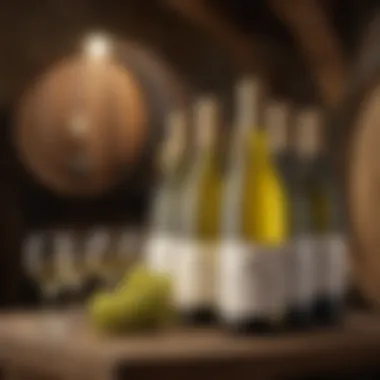

For pork lovers, consider pairing Chardonnay with dishes such as:
- Pork tenderloin with a creamy mustard sauce.
- Roast pork with fruit accents, for example, apple or apricot.
These combinations highlight Chardonnay's adaptability. They bring forward its inherent fruitiness while keeping the meal balanced.
Vegetarian Options
Vegetarian options can often provide unique pairing opportunities for Chardonnay. The key is to focus on the textures and flavors of vegetables and grains. A vegetable risotto made creamy can be splendid with a rich Chardonnay, as the wine's fruity aroma complements the dish generously.
Another rewarding pairing includes roasted vegetables seasoned with herbs. The earthy characteristics merge well with certain styles of Chardonnay. Some excellent vegetarian dishes suited for Chardonnay include:
- Grilled asparagus with lemon zest.
- Mushrooms in cream sauce or on a risotto base.
- Caprese salad drizzled with balsamic reduction.
These pairings offer fresh possibilities, showing that our understanding of Chardonnay is not limited to meat and seafood.
Pairing Chardonnay with food effectively can transform any meal into a sophisticated experience, making it an essential skill for wine enthusiasts.
Serving and Storing Chardonnay
Serving and storing Chardonnay correctly is crucial for enhancing the enjoyment of this renowned varietal. Proper serving techniques and storage conditions directly influence the wine’s characteristics, subtly highlighting its unique flavors and aromas. Understanding these aspects empowers both casual drinkers and avid connoisseurs to appreciate Chardonnay fully. In this section, we will cover the optimal temperature for serving and the best practices for storing Chardonnay.
Optimal Serving Temperature
The serving temperature of Chardonnay plays a significant role in how the wine is experienced. Optimal temperature can vary slightly depending on the style of Chardonnay. Generally, oaked Chardonnays are best enjoyed at a slightly warmer temperature, usually between 50°F to 55°F (10°C to 13°C). This allows the rich, buttery flavors to develop fully. On the other hand, unoaked Chardonnay, which highlights freshness and acidity, benefits from cooler serving temperatures. Aim for 45°F to 50°F (7°C to 10°C) in this case.
Here are some tips to maintain perfect serving temperature:
- Refrigerate in Advance: Chill your Chardonnay for a few hours before serving.
- Use Ice Buckets: If necessary, an ice bucket can be a quick solution to drop the temperature just before pouring.
- Thermometers: Invest in a wine thermometer to gauge temperatures accurately, ensuring your choice is neither too warm nor too chilled.
In summary, being aware of the nuances in serving temperatures significantly enhances the tasting experience, making it a key consideration for appreciating Chardonnay.
Proper Storage Techniques
Proper storage techniques are essential for preserving the quality and integrity of Chardonnay over time. Incorrect storage can lead to spoilage, minimizing the joy of subsequent tastings. Take note of the following factors that impact Chardonnay storage:
- Temperature Stability: It is vital to store wine at a consistent temperature. The ideal range for Chardonnay is between 45°F to 65°F (7°C to 18°C). However, avoid frequent fluctuations in temperature.
- Humidity Level: Aim for a humidity level of around 70% to prevent cork drying and wine evaporation. Too much humidity, however, can lead to mold.
- Darkness and Vibration: Store Chardonnay in a dark place, away from direct sunlight to protect it from light damage. Similarly, the wine should be kept away from vibration, which may disturb the sediment in the bottle.
- Storing Position: Keep bottles horizontal. This ensures that the wine remains in contact with the cork, preventing it from drying out.
Proper storage techniques are as essential as optimal serving temperatures when it comes to genuine enjoyment of Chardonnay.
To conclude, understanding the proper serving and storage of Chardonnay is pivotal for promoting its delightful construction and aging potential. Elegantly storing and serving wine mellows its taste and enhances the tasting experience, making it a rewarding acknowledgment within any wine enthusiast's routine.
Epilogue
The conclusion of this article encapsulates the intricate world of Chardonnay, highlighting its myriad of flavors, styles, and potential pairings. Understanding Chardonnay offers wine enthusiasts unique advantages in personal wine selection, whether one is a novice or an experienced connoisseur. The knowledge gained through this exploration will enhance one's ability to identify high-quality options and appreciate the various nuances of this celebrated varietal.
In summary, studying the complexity of Chardonnay provides several benefits, including:
- Diverse Knowledge: Gaining a deep understanding of different Chardonnay styles and the nuances introduced by terroir.
- Appropriate Pairings: Learning how to effectively pair Chardonnay with food, enhancing the overall dining experience.
- Informed Choices: Making more enlightened selections at the store or while dining out, ultimately enabling better enjoyment of the wine.
It is important to recognize the impact that proper serving methods, storage conditions, and production techniques hold in defining a bottle’s quality. A well-explored appreciation of Chardonnay empowers individuals to explore further into the vast sea of white wines available, ultimately leading to discovery and enjoyment.
Summary of Key Points
Throughout the article, we discussed:
- The origins and global reach of Chardonnay.
- The unique characteristics that define its multiple styles, including oaked and unoaked varieties.
- The crucial role of terroir, focusing on soil types and climatic conditions that influence flavor and quality.
- Various food pairings that complement your Chardonnay choice, from seafood to vegetarian options.
- Tips on proper serving temperatures and storage techniques for maximizing enjoyment.
This sets a strong foundation for anyone looking to engage more seriously with Chardonnay and its offerings.
Encouragement to Explore
As this article comes to a close, it is fitting to encourage readers to take a further step into the realm of Chardonnay. Explore your local wine shops, attend tastings, and interact with knowledgeable staff. Visiting vineyards can provide novel insights, along with firsthand experience of varietals from their terroir.
Try different regions; notice how a California Chardonnay can starkly differ from a Burgundy selection, both in taste and nuance. There is a wealth of knowledge and enjoyment awaiting among this varietal, and your exploration will be enriched profoundly by ongoing engagement.
By taking informed actions and arming oneself with the insights shared in this article, one can truly savor the delights that a glass of Chardonnay provides.






